|
|||||||||
|
Test pilots blended science and art in a sometimes-deadly dance of exploration. They were the pioneers who blazed the first trails across new aeronautical frontiers. Essential members of the Vought organization from the very beginning, many test pilots were employed between 1917 and the 1990s.
All test pilots came to Vought with high levels of flight experience. Most had thousands of flying hours in their log books. They were all initially educated in science or engineering. All were former military pilots. Since all military flying until very recent times was restricted to men, there was never a female Vought test pilot. The job itself was a unique blend of insight and logic. The test pilot had to have the hard-nosed engineering objectivity of the scientist. That had to be combined that with the quick-thinking reflexes and knowledgeable instinct for self-preservation of the snake-charmer. On the one hand, the test pilot had to be able to instantly establish a feel for the aircraft and to sense unseen and unanticipated events. This sometimes required almost supernatural abilities to know what the airplane was about to do next. He had to decide in an instant whether to sit back and relax, take some corrective action, or eject. On the other hand, he had to maintain a disciplined engineering approach to everything he saw and heard. Above all, he had to faithfully record the information required on every flight. Each and every test flight detail was planned well in advance. The specific test aircraft was fitted with all needed instruments and recording devices. A flight plan was developed that specified every maneuver to be performed. The test pilot had to fly the precise path in the sky defined by the flight plan. He had to fly at the exact speed and altitude and at the exact heading and aircraft attitude. He had to fly the profile for a precise amount of time at the correct weight and center of gravity while recording each data point. Sometimes another test pilot flew a chase plane and accompanied the test flight aircraft. This allowed a movie of the test flight to be shot. The chase plane could also take still photographs of the test flight or observe parts of the test aircraft that couldn’t be seen by the test pilot.
Flown by veteran test pilot Boone Guyton, the V-173 was made of wood and looked like a flying saucer. It had a round flat body, twin engines buried in the fuselage, and two large propellers at the front. In spite of wind tunnel testing and engineering analyses, no one was really sure what would happen once the airplane was in the air. If all went well, the design might dramatically increase the speed of fighter aircraft. This could give the U.S. a great edge in winning World War II. The flight, however, did not go well. In fact, Boone Guyton instantly discovered the V-173 had serious handling problems. Pointed out to sea over Long Island Sound, Boone found that the airplane would not turn. With a limited amount of fuel onboard and England the nearest landfall straight ahead, the situation quickly became ominous. Boone refused to panic or to lose the valuable test aircraft by bailing out or ditching it in the ocean. Instead, he methodically examined his control options. He tried everything his background and instincts could suggest. He found that the nose of the V-173 could be nudged around a few degrees if he pushed and momentarily held the rudder. Every time he did this the airplane skidded in the air and the nose returned almost to its original heading, but he gained a few degrees. By repeating this action over and over he was finally able to point the airplane at Connecticut instead of Europe. There was a happy ending when Boone made a smooth landing at the Chance Vought factory airfield after a harrowing 14-minute flight. The airplane design, however, wasn’t a success. The new jet engines just coming into use made it possible for more conventional and better-understood airplane configurations to fly much faster than propeller designs. The “Flying Pancake” became just another aviation curiosity. It was soon out of sight and relegated to the history books. The airplane did, however, add extreme interest to the life of Boone Guyton for a few tense minutes. The opinion of the test pilot was extremely important and valuable when a new aircraft was being developed. The test pilot provided a summary of his impressions and observations after every flight. The rule was that a new airplane was flown by only one test pilot. In this way only a single set of ideas about aircraft handling and performance was considered. While this might seem to limit the potential for finding and solving problems, or for improvements, it also prevented confusion. Test pilots are justly renowned for their confidence and firmness of opinions, sometimes erroneously thought of as ego. If two pilots fly the same aircraft you’ll probably get two different opinions. Worse yet, the opinions may be totally opposed to each other. In the earliest stages of development it was thought best to limit suggestions and impressions to a single test pilot. Others would have opportunities to also fly and evaluate the airplane at later dates. There were basically two categories of test flying. The first was for new developmental aircraft designs. These had to be tested and evaluated. This could sometimes take many months as modifications and corrections were made to the airplane and its numerous systems. The second type of test flying was for production aircraft. Once production started, each and every new airplane rolling off the assembly line had to be first flown by a company test pilot. These production test pilots ensured it was O.K. to turn the airplane over to the government test pilot. The government test pilot, usually from the Navy or Air Force, would make the acceptance test flight. The government pilot verified that all specifications were met. He then formally accepted the aircraft into the government inventory. Another government pilot made the ferry flight to deliver the aircraft to its initial service destination. Vought also provided maintenance and overhaul for military aircraft. This sometimes required complete disassembly, repair of structure and components as necessary, and installation of upgrades, new engines, electronics and other systems. The entire aircraft and all its systems were then put back together to create a virtually new airplane. Each newly completed aircraft was put through its paces by production test pilots to verify the many changes and repairs.
Test pilots were integral and important members of the marketing and selling organization. They flew new company aircraft at air shows. They also talked to government customers about the handling and other flight qualities of particular airplane designs. This was especially important when Vought aircraft were being considered for sale to foreign governments. Foreign test pilots and other military personnel would visit Vought for briefings and test flights. They would be given instruction in aircraft systems by technical specialists. They were allowed to fly for evaluation under the close supervision of Vought test pilots. They would also gather information on maintenance and support to aid in making a final buying decision. Any actual sale was government-to-government. Vought sold the airplane to the U.S. government, who then sold it to the foreign government. Whether selling new airplanes or helping design them, the test pilots displayed scientific judgment and skill combined with courage and the ability to think coolly under dangerous and threatening conditions.
|


 In earlier times, test pilots tended to be largely self-taught. They were attracted to test flying by the challenge and the bonus money offered for the dangerous work. As the aeronautical sciences matured and grew, test pilots received more formal training. After World War II, most pilots came to Vought from four primary sources. The first two were the formal military test pilot schools at Patuxent River Naval Air Station and Edwards Air Force Base. Aviator graduates of these schools who retired from military service often took new jobs with Vought. The British also had a test pilot school at Farnborough and the French had another at Istres. Both American and foreign pilots who graduated from any of these schools were eligible for test flying.
In earlier times, test pilots tended to be largely self-taught. They were attracted to test flying by the challenge and the bonus money offered for the dangerous work. As the aeronautical sciences matured and grew, test pilots received more formal training. After World War II, most pilots came to Vought from four primary sources. The first two were the formal military test pilot schools at Patuxent River Naval Air Station and Edwards Air Force Base. Aviator graduates of these schools who retired from military service often took new jobs with Vought. The British also had a test pilot school at Farnborough and the French had another at Istres. Both American and foreign pilots who graduated from any of these schools were eligible for test flying.
 For some new aircraft designs, the first flight could require every ounce of engineering knowledge, courage, and creative thinking the test pilot could summon. One of the best examples of this occurred when the radically different V-173 “Flying Wing” (also known as the “Flying Pancake”) prototype took off from the Chance Vought airfield in Connecticut in November, 1942.
For some new aircraft designs, the first flight could require every ounce of engineering knowledge, courage, and creative thinking the test pilot could summon. One of the best examples of this occurred when the radically different V-173 “Flying Wing” (also known as the “Flying Pancake”) prototype took off from the Chance Vought airfield in Connecticut in November, 1942.
 Ordnance bunkers on company property contained all the ammunition, bombs, rockets, and other military weapons carried or used by the aircraft. Vought test pilots would strap into fully loaded fighter and attack airplanes and taxi through the gate onto the Dallas Naval Air Station runway. They would then take off for firing runs on government ranges near the Texas coast. Bombs could be jettisoned at sea over the Gulf of Mexico, if necessary.
Ordnance bunkers on company property contained all the ammunition, bombs, rockets, and other military weapons carried or used by the aircraft. Vought test pilots would strap into fully loaded fighter and attack airplanes and taxi through the gate onto the Dallas Naval Air Station runway. They would then take off for firing runs on government ranges near the Texas coast. Bombs could be jettisoned at sea over the Gulf of Mexico, if necessary.